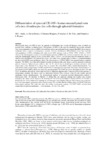Mostrar o rexistro simple do ítem
Differentiation of Synovial CD-105+ Human Mesenchymal Stem Cells into Chondrocyte-like Cells through Spheroid Formation
| dc.contributor.author | Arufe, M.C. | |
| dc.contributor.author | Fuente, Alexandre de la | |
| dc.contributor.author | Fuentes Boquete, Isaac Manuel | |
| dc.contributor.author | De-Toro, Javier | |
| dc.contributor.author | Blanco García, Francisco J | |
| dc.date.accessioned | 2015-11-20T10:00:21Z | |
| dc.date.available | 2015-11-20T10:00:21Z | |
| dc.date.issued | 2009-06-18 | |
| dc.identifier.citation | Arufe MC, De la Fuente A, Fuentes-Boquete I, De Toro FJ, Blanco FJ. Differentiation of synovial CD-105+ human mesenchymal stem cells into chondrocyte-like cells through spheroid formation. J Cell Biochem. 2009;108(1):145-155 | es_ES |
| dc.identifier.uri | http://hdl.handle.net/2183/15577 | |
| dc.description.abstract | [Abstract] Mesenchymal stem cells (MSCs) have the capacity to differentiate into several cell lineages, some of which can generate bone, cartilage, or adipose tissue. The presence of MSCs in the synovial membrane was recently reported. Data from comparative studies of MSCs derived from various mesenchymal tissues suggest that MSCs from synovial membranes have a superior chondrogenesis capacity. Previous chondrogenic differentiation studies have used the total population of MSCs, including cells with several MSC markers, such as CD44, CD90, CD105, or CD73. However the chondrogenic capacity of an individual population of MSCs has not been examined. Our aim was to study the chondrogenic capacity of the cellular MSC subset, CD105+, derived from synovial membrane tissues of patients with osteoarthritis (OA) and normal donors. The tissues were digested with a cocktail of collagenase/dispase and the isolated MSCs were seeded into plates. The subpopulation of CD105+-MSCs was separated using a magnetic separator. The MSCs were then differentiated towards chondrocyte-like cells using a specific medium to promote spheroid formation. Spheroids were collected after 14, 28, and 46 days in chondrogenic medium and stained with hematoxylin, eosin, Safranin O or Alcian blue to evaluate the extracellular matrix. Immunohistochemistry was performed to study collagen types I (COLI) and II (COLII) and aggrecan expression. Phenotypic characterization of the isolated CD105+-MSCs shows that these cells are also positive for CD90 and CD44, but negatives for CD34 and CD45. In addition, this cellular subset expressed Sox-9. Spheroids appeared after 7 days in culture in the presence of chondrogenic medium. Our studies show no differences between MSCs obtained from OA and normal synovial membranes during chondrogenesis. The morphological analysis of spheroids revealed characteristics typical of chondrocyte cells. The intensity of Safranin O, Alcian blue and aggrecan staining was positive and constant throughout the culture period. However, the intensity of COL2 staining was higher at 28 days (84.29 ± 0.1 U) than at 46 days (61.28 ± 01 U), while COL1 staining was not detected in any samples analyzed. These results were confirmed by reverse transcriptase-polymerase chain reaction assays. We conclude that the cellular subset of CD105+-MSCs has chondrogenic capacity. The study also show the similar chondrogenic capacity of CD105+-MSCs cultured from normal and OA synovial membranes. J. Cell. Biochem. 108: 145–155, 2009. | es_ES |
| dc.description.sponsorship | Servizo Galego de Saúde; PS07/86 | es_ES |
| dc.language.iso | eng | es_ES |
| dc.publisher | Wiley | es_ES |
| dc.relation.uri | http://dx.doi.org/10.1002/jcb.22238 | es_ES |
| dc.rights | This is the peer reviewed version of the article which has been published in final form at Wiley Online Library. This article may be used for non-commercial purposes in accordance with Wiley Terms and Conditions for self-archiving | es_ES |
| dc.subject | Mesenchymal stem cells | es_ES |
| dc.subject | Spheroids | es_ES |
| dc.subject | Osteoarthritis | es_ES |
| dc.subject | Chondrocyte-like cells | es_ES |
| dc.subject | CD-105+ | es_ES |
| dc.title | Differentiation of Synovial CD-105+ Human Mesenchymal Stem Cells into Chondrocyte-like Cells through Spheroid Formation | es_ES |
| dc.type | info:eu-repo/semantics/article | es_ES |
| dc.rights.access | info:eu-repo/semantics/openAccess | es_ES |
Ficheiros no ítem
Este ítem aparece na(s) seguinte(s) colección(s)
-
GI-TCMR - Artigos [130]
-
INIBIC-TCMR - Artigos [102]
-
INIBIC- REUMA - Artigos [184]






